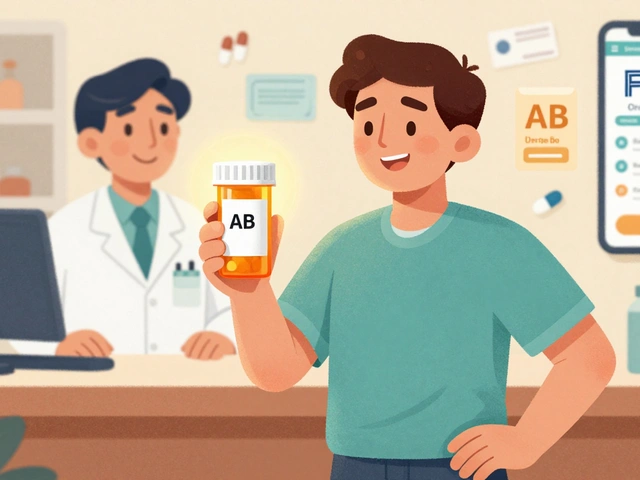Floxin (Ofloxacin) vs. Alternatives Comparison Tool
Key Factors Considered:
- Infection Type:
- Patient Age Group:
- Resistance Patterns:
Comparison Results
When a doctor prescribes Floxin is a brand name for the fluoroquinolone antibiotic ofloxacin, patients often wonder if there’s a safer or more effective option. This guide breaks down how Ofloxacin works, who should use it, and how it stacks up against the most common alternatives such as ciprofloxacin, levofloxacin, moxifloxacin, azithromycin, and amoxicillin. By the end you’ll know which drug fits a particular infection, what side‑effects to watch for, and why resistance matters.
How Ofloxacin (Floxin) Works
Ofloxacin belongs to the fluoroquinolone class, which targets bacterial DNA gyrase and topoisomerase IV. Disrupting these enzymes stops bacteria from replicating their DNA, leading to cell death. It’s a broad‑spectrum drug, effective against many Gram‑negative and some Gram‑positive organisms, making it a go‑to for urinary tract infections (UTIs), respiratory infections, and skin infections.
Key Alternatives to Consider
Not all infections need a fluoroquinolone, and many clinicians prefer other families to avoid side‑effects or resistance. Below are the six most frequently discussed alternatives.
- Ciprofloxacin - another fluoroquinolone, slightly stronger against Gram‑negative bugs but similar safety profile.
- Levofloxacin - a newer fluoroquinolone with better lung penetration, often used for pneumonia.
- Moxifloxacin - a respiratory‑focused fluoroquinolone, covers atypical pathogens.
- Azithromycin - a macrolide that’s gentler on tendons and the gut, popular for chlamydia and some respiratory infections.
- Amoxicillin - a penicillin‑type beta‑lactam, first‑line for many ear, nose, and throat infections.
- Nitrofurantoin - a urinary‑tract‑specific agent, rarely causes systemic side‑effects.
Side‑Effect Profile: What Sets Ofloxacin Apart
Fluoroquinolones share a handful of class‑wide warnings: tendon rupture, QT‑interval prolongation, and peripheral neuropathy. Ofloxacin’s risk for tendon injury is slightly lower than ciprofloxacin’s, but still higher than macrolides or beta‑lactams. Common mild side‑effects include nausea, diarrhea, and headache. In contrast, azithromycin often causes GI upset but rarely impacts tendons, while amoxicillin can trigger allergic reactions in up to 10% of patients.
Resistance Trends (2023‑2025)
Globally, fluoroquinolone resistance has risen sharply, especially among Escherichia coli (E.coli) causing UTIs. A 2024 European surveillance report showed 22% resistance to ofloxacin in community‑acquired UTI isolates, versus 12% for nitrofurantoin. Conversely, azithromycin resistance in Streptococcus pneumoniae dropped to 8% after stewardship programs reduced over‑prescribing.

Comparison Table: Ofloxacin and Its Main Rivals
| Drug | Class | Typical Indications | Key Strengths | Major Risks | Resistance Rate (2024) |
|---|---|---|---|---|---|
| Ofloxacin (Floxin) | Fluoroquinolone | UTI, respiratory, skin | Broad‑spectrum, good oral bioavailability | Tendon rupture, QT prolongation | 22% (E.coli UTI) |
| Ciprofloxacin | Fluoroquinolone | UTI, gastroenteritis | Strong Gram‑negative kill | Higher tendon risk, CNS effects | 25% (E.coli UTI) |
| Levofloxacin | Fluoroquinolone | Pneumonia, sinusitis | Excellent lung penetration | QT prolongation, photosensitivity | 18% (S.pneumoniae) |
| Moxifloxacin | Fluoroquinolone | Community‑acquired pneumonia | Atypical pathogen coverage | Hepatotoxicity, QT risk | 12% (S.pneumoniae) |
| Azithromycin | Macrolide | Chlamydia, atypical pneumonia | Gentle GI profile, once‑daily dosing | Potential drug‑drug interactions | 8% (S.pneumoniae) |
| Amoxicillin | Beta‑lactam | Ear, sinus, throat infections | Low resistance in common ENT bugs | Allergy, C.difficile risk | 5% (H.influenzae) |
| Nitrofurantoin | Urinary‑tract specific | Uncomplicated UTI | Minimal systemic side‑effects | Pulmonary toxicity (rare) | 3% (E.coli UTI) |
When to Choose Ofloxacin Over Alternatives
Ofloxacin shines when you need a single oral agent that covers both Gram‑negative and some Gram‑positive bacteria, especially if the infection is mixed (e.g., a diabetic foot ulcer with multiple flora). It’s also handy when a patient can’t tolerate penicillins or macrolides due to allergies. However, if the infection is clearly caused by a pathogen known to be fluoroquinolone‑resistant, or if the patient is over 60 with a history of tendon problems, a non‑fluoroquinolone option is safer.
Practical Tips for Prescribers and Patients
- Confirm the likely pathogen with a culture whenever possible; this narrows the need for broad‑spectrum drugs.
- Check for drug‑drug interactions: fluoroquinolones can increase levels of warfarin, theophylline, and certain antidiabetics.
- Warn patients to avoid strenuous exercise for at least a month after finishing the course to reduce tendon‑rupture risk.
- Consider dose adjustments in renal impairment; Ofloxacin’s dose halves when creatinine clearance < 30mL/min.
- Educate about signs of serious side‑effects: sudden joint pain, palpitations, or visual changes require immediate medical attention.
Frequently Asked Questions
Is Ofloxacin safe for pregnant women?
Fluoroquinolones, including Ofloxacin, are classified as pregnancy category C. They should be avoided unless the benefits clearly outweigh the risks. Safer alternatives for most infections in pregnancy are amoxicillin or azithromycin.
Can I take Ofloxacin with antacids?
Antacids containing magnesium or aluminum can bind Ofloxacin and lower its absorption. Take the antibiotic either 2hours before or 2hours after the antacid.
What’s the difference between Ofloxacin and Ciprofloxacin?
Both are fluoroquinolones, but ciprofloxacin is stronger against Pseudomonas and other Gram‑negative organisms. Ofloxacin has a slightly better safety profile for tendons, but the two share most class warnings.
Why is my doctor prescribing a fluoroquinolone instead of a penicillin?
If the suspected bug is resistant to penicillins, or if the infection is deep‑seated (e.g., bone or prostate), a fluoroquinolone offers better tissue penetration and a broader spectrum.
How long should I take Ofloxacin for a urinary tract infection?
Typical adult regimens are 200mg twice daily for 3days for uncomplicated UTIs. Longer courses are reserved for complicated infections or kidney involvement.
Bottom Line
If you need a potent, orally available drug that tackles a wide range of bacteria, Ofloxacin alternatives like levofloxacin or ciprofloxacin are viable options, but they carry the same class warnings. For most community infections where resistance is low, narrowing to a macrolide or beta‑lactam reduces side‑effects and helps preserve fluoroquinolone efficacy for the harder‑to‑treat cases.









Breanne McNitt
3 Oct 2025 at 17:34Ofloxacin can be a solid choice when you need a single pill that tackles both Gram‑negative and some Gram‑positive bugs, especially for mixed infections like diabetic foot ulcers. It’s handy for patients allergic to penicillins or macrolides, but you still have to watch out for the tendon‑rupture warning. If the infection’s likely caused by a fluoroquinolone‑susceptible organism, the oral bioavailability makes it convenient compared to IV options.